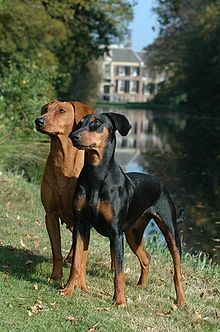German Pinscher

A red and a tan-and-black pinscher with natural ears
|
||||||||||||||||||||||||||
| Other names | Deutscher Pinscher | |||||||||||||||||||||||||
|---|---|---|---|---|---|---|---|---|---|---|---|---|---|---|---|---|---|---|---|---|---|---|---|---|---|---|
| Origin | Germany | |||||||||||||||||||||||||
|
||||||||||||||||||||||||||
| Domestic dog (Canis lupus familiaris) | ||||||||||||||||||||||||||
| Classification / standards | |||
|---|---|---|---|
| FCI | Group 2, Section 1.1 Pinscher #184 | standard | |
| AKC | Working | standard | |
| ANKC | Group 6 - Utility | standard | |
| CKC | Group 6 - Non-Sporting | standard | |
| KC (UK) | Working | standard | |
| NZKC | Utility | standard | |
| UKC | Terrier | standard | |
The German Pinscher (original name Deutscher Pinscher, FCI No. 184) is a medium-sized breed of dog, a Pinscher type that originated in Germany. The breed is included in the origins of the Dobermann, the Rottweiler, the Miniature Pinscher, the Affenpinscher, the Standard Schnauzer (and, by extension, the Miniature Schnauzer and Giant Schnauzer). The breed is rising in numbers in the U.S., mainly due to their full acceptance to AKC in 2003. In Australia, the breed is established with a rise in popularity becoming evident.
The German Pinscher is a medium-sized dog, usually weighing between 25–45 pounds (11–20 kilograms) and typically 17–20 inches (43–51 centimetres) in height, with a short coat. Colors for this breed include black and rust, red, fawn, blue and tan. The ideal German Pinscher is elegant in appearance with a strong square build and moderate body structure, muscular and powerful endurance and agility. For all countries where the Fédération Cynologique Internationale standard applies, only black and rust and solid red are allowed colors. Colors that became extinct during the world wars of the twentieth century include solid black, salt-and-pepper, and harlequin.
German Pinschers customarily have their tails docked and ears cropped, as has been done for over 200 years, in countries where the procedures are legal. Historically, tail docking was thought to prevent rabies, strengthen the back, increase the animal's speed, and prevent injuries when working. For utilitarian reasons, ears also were cropped, to prevent injuries while working and increase the intense appearance of the canine and eliminate the subdued, "puppy" look of droopy ears. Today, these are both done mainly for cosmetic reasons, though many accounts of injuries to undocked tails and uncropped ears of unaltered dogs have been reported and recognized by the American Kennel Club. Cropping and docking should only be done by a licensed veterinarian. While the altered or natural state of a German Pinscher should not affect a judge's decision in the show ring, prejudices do exist. Even many foreign judges who officiate at AKC events comment on how they appreciate seeing dogs docked and cropped.
...
Wikipedia
